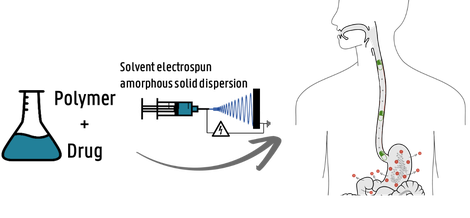Therapeutic nanofibers for drug delivery
How nanofibers can heal you faster
Through solvent electrospinning we have found that it is possible to incorporate poorly soluble drugs inside nanofibers. Not only does this lead to time-stable formulations, we have succeeded in obtaining a formulation which is 5 times more efficient compared to conventional formulation techniques.
For oral drug delivery, nanofibrous formulations are a vital advancement. Over 60% of all active pharmaceutical ingredients - drugs - suffer from a low water solubility, meaning that it is getting more and more challenging to find an efficient oral formulation for new drugs. This can mainly be attributed to their crystalline structure, which you can envision as a highly ordered and rigid structure composed of little drug molecules. To break it up requires a lot of energy. Sadly, those little drug molecules have to be separated in order to get them solubilized, else the drug won’t have a therapeutic effect. Luckily, another structure is possible: the amorphous structure. In this form, all drug molecules are arranged in a less ordered manner, meaning they can move more freely inside the structure. To break up such an amorphous arrangement requires a great deal less energy compared to breaking up the crystalline formation. Consequently, making the drug amorphous means that the aqueous solubility is improved.
How do we achieve this change in solid structure? Solvent electrospinning. This polymer processing technique enables the drawing of a polymer solution into a nanofibrous membrane with average fiber diameters below 500 nm. It is a versatile and upscalable technique which leads to nanofibers with advantageous properties such as a very large specific surface area, which is beneficial for speeding up solubilization. Based on our results, we believe that the most promising aspect of solvent electrospinning is its rapid solvent evaporation. We start from a solution where both a polymer and a drug are dissolved in a common solvent. During the process the solvent evaporates so fast that the drug molecules don’t get the time to arrange themselves. They get frozen into place randomly and thus amorphously. The result is a membrane made of nanofibers with the drug well-dispersed inside of it, and in its more soluble form. These nanofibrous membranes are consequently tested for their time stability and release rate. Our results show that in one hour, five times more drug gets released when it is solvent electrospun compared to the drug in its crystalline form.
This highly interdisciplinary research is based on collaborations between the Centre for Textile Science and Engineering, the Supramolecular Chemistry group and the Laboratory for Pharmaceutical Technologies, all at Ghent University. Combining the expertise of these groups has already lead to essential insights into the interactions between polymers and drugs and the effect of solvent electrospinning on those interactions. The collaborations also allow for in-house analysis of the formulation, including modulated differential scanning calorimetry, X-ray diffraction, infrared spectroscopy and UV-Vis spectroscopy.
Further information
- Patent application (EP 21216446.1)
- Article in EOS Wetenschap Magazine, 2019 Edition no. 5, May 2019
- Parts of this research have received awards: Jana Becelaere – 1st EOS poster prize at the FEA research symposium (Ghent, 2019)
Acknowledgements
This research has been and still is part of several Ph.D. projects:
- Ir. Olmo Frateur (funded by the FWO Flanders strategic basic research grant 1S22722N)
- Ir. Jana Becelaere (funded by the FWO Flanders strategic basic research grant 1S89120N)
Contact
Prof. dr. ir. Karen De Clerck (Karen.DeClerck@UGent.be)
